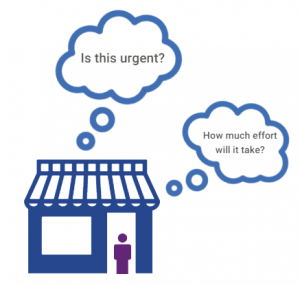For business owners, it’s not just the medical risks to you, your family or your colleagues that will be top of mind – it will be the survival of your business through this period.
To offer some practical support, we’ve launched this series of blogs – SME Business Resilience – to help business owners prioritise the key actions that will enable them to keep their business going during lockdown, pay their staff and suppliers, keep serving customers where possible, and help their local communities in a practical way. We’ll also use this series to point you in the direction of the key financial and non-financial support mechanisms that are already there or being launched in response to the global pandemic.
This blog focuses on one of those painful yet critical tasks – prioritising.
Getting things together
Right now, it can seem difficult to focus on what needs doing first. Whether it’s taking care of the family, helping staff by accessing furlough schemes, applying for a CBIL or looking at what assets you could draw down from to help your business survive; there is so much to do it can sometimes feel like trying to build a house for someone who hasn’t made up their mind whether they want a bungalow or a mansion.
There are many ways to prioritise and some that are even great for situations where change is constant. Lots of businesses already take what is known as ‘an agile approach’ to pretty much everything and whilst ‘agile‘ has it routes in manufacturing and software development, any business can think in an agile way to help them focus on key tasks and balance their resources in the most efficient way.
First off, it can help to make a simple list of everything that needs to be done. You can use some post-its, a Notes app on your phone or a free task app like Trello or Google Tasks to list out everything that you want to get done. Start with single words or short sentences.
Once you have your list, try and expand the detail a little by thinking about what it’s worth to you. You could assign a monetary value or score each task on a scale of 1-3 with 1 being Must Get Done Now and 3 being It can wait a couple of weeks. Whatever helps you think about the most beneficial task to tackle first will be the right thing for you.
Next, in order to get each task done, what will it take? Again, think about a scoring mechanism that works for you – is it person hours, money spent or another 1-3 scale of effort?
With both those scores you can combine them to get some form of priority so you can either tackle the easiest one first or choose to tackle the one that brings in the most money, or benefits you the most in some other way. You’ll probably find that by combining the scores, you can pick between those high priority ones by the relative effort, so it feels like your maximising your time and budget and your income/benefit.
Sharing the load
You may actually want to run this process with your colleagues to get more insight into what can best help your business – they may bring valuable data that could make you even slicker.
Once you have your prioritised list, share it. Put the post-its on a wall or share the digital list via an app, shared document or just via email.
You’ll also want to consider whether you can assign some of the tasks to others for completion (or partial completion). For example, if you need to make some payments to suppliers, ask one of your team to give each of them a call to find out what their situation is and whether paying them first could help them with their own priorities or perhaps whether they’d be willing to defer your payment for a while or split the payment into chunks. We’ll talk more about payments and how this particular area can support your business in a future blog.
Getting things done
Once you’ve prioritised your tasks and started working through them (one at a time if you can!), remember to measure progress and celebrate success by marking things as complete, before you move on to the next one.
Hopefully, you’ll find that taking this kind of approach will give you a more positive experience during these testing times and help you to clear your mind, so you can focus on what will make the biggest difference to your business, your staff and your family.
Thinking about tomorrow
By thinking carefully about what actions you need to prioritise and the impact they will have, you will be able to free up the time you need to get on to those tasks that are going to make all the difference – things like applying for CBILS or adapting your business to keep delivering products to customers or preparing for some form of return to ‘normal’ in the coming months by locating and building an understanding of potential new customers.
With the finance side of things being so important, our next blog(s) will zoom in on a few key topics such as the support available and how to help improve some of the financial building blocks that underpin your access to finance.
